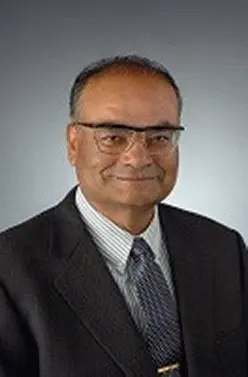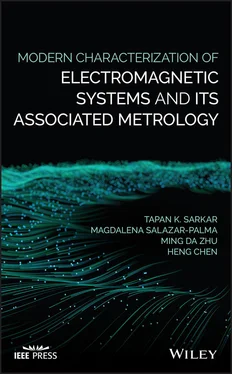1 ...8 9 10 12 13 14 ...18 This book is intended for engineers, researchers and educators who are planning to work in the field of electromagnetic system characterization and also deal with their measurement techniques and philosophy. The prerequisite to follow the materials of the book is a basic undergraduate course in the area of dynamic electromagnetic theory including antenna theory and linear algebra. Every attempt has been made to guarantee the accuracy of the content of the book. We would however appreciate readers bringing to our attention any errors that may have appeared in the final version. Errors and/or any comments may be emailed to one of the authors, at salazar@tsc.uc3m.es, mingda.zhu@live.com, hchen43@syr.edu.
Grateful acknowledgement is made to Prof. Pramod Varshney, Mr. Peter Zaehringer and Ms. Marilyn Polosky of the CASE Center of Syracuse University for providing facilities to make this book possible. Thanks are also due to Prof. Jae Oh, Ms. Laura Lawson and Ms. Rebecca Noble of the Department of Electrical Engineering and Computer Science of Syracuse University for providing additional support. Thanks to Michael James Rice, Systems administrator for the College of Engineering and Computer Science for providing information technology support in preparing the manuscript. Also thanks are due to Mr. Brett Kurzman for patiently waiting for us to finish the book.
Tapan K. Sarkar
Magdalena Salazar Palma (salazar@tsc.uc3m.es)
Ming‐da Zhu (mingda.zhu@live.com)
Heng Chen (hchen43@syr.edu)
Syracuse, New York
Tribute to Tapan K. Sarkar by Magdalena Salazar Palma, Ming Da Zhu, and Heng Chen

Professor Tapan K. Sarkar, PhD, passed away on 12 March 2021. The review of the proofs of this book is probably the last task he was able to accomplish. Thus, for us, his coauthors, this book will be always cherished and valued as his last gift to the scientific community.
Dr. Sarkar was born in Kolkata, India, in August 1948. He obtained his Bachelor of Technology (BT) degree from the Indian Institute of Technology (IIT), Kharagpur, India, in 1969, the Master of Science in Engineering (MSCE) degree from the University of New Brunswick, Fredericton, NB, Canada, in 1971, and the Master of Science (MS) and Doctoral (PhD) degrees from Syracuse University, Syracuse, NY, USA, in 1975. He joined the faculty of the Electrical Engineering and Computer Science Department at Syracuse University in 1979 and became Full Professor in 1985. Prior to that, he was with the Technical Appliance Corporation (TACO) Division of the General Instruments Corporation (1975–1976). He was also a Research Fellow at the Gordon McKay Laboratory for Applied Sciences, Harvard University, Cambridge, MA, USA (1977–1978), and was faculty member at the Rochester Institute of Technology, Rochester, NY, USA (1976–1985). Professor Sarkar received the Doctor Honoris Causa degree from Université Blaise Pascal, Clermont Ferrand, France (1998), from Polytechnic University of Madrid, Madrid, Spain (2004), and from Aalto University, Helsinki, Finland (2012). He was now emeritus professor at Syracuse University. Professor Sarkar was a professional engineer registered in New York, USA, and the president of OHRN Enterprises, Inc., a small business founded in 1986 and incorporated in the State of New York, USA, performing research for government, private, and foreign organizations in system analysis.
Dr. Sarkar was a giant in the field of electromagnetics, a phenomenal researcher and teacher who also provided an invaluable service to the scientific community in so many aspects.
Dr. Sarkar research interests focused on numerical solutions to operatorequations arising in electromagnetics and signal processing with application to electromagnetic systems analysis and design and with particular attention to building solutions that would be appropriate and scalable for practical adoption by industry. Among his many contributions together with his students and coworkers, it may be mentioned the development of the generalized pencil‐of‐function (GPOF) method, also known as matrix pencil method, for signal estimation with complex exponentials. Based on Dr. Sarkar group’s work on the original pencil‐of‐function method, the technique is used in electromagnetic analyses of layered structures, antenna analysis, and radar signal processing. He is also coauthor of the general purpose electromagnetic solver HOBBIES (Higher Order Basis Based Integral Equation Solver). The list of Professor Sarkar’s original and substantive contributions to the field of computational electromagnetics and antenna theory is quite long. Just to name a few, these include methods of evaluating the Sommerfeld integrals, the already mentioned matrix pencil method for approximating a function by a sum of complex exponentials, the conjugate gradient method and fast Fourier transform method for the efficient numerical solution of integral equations having convolutional kernels, the introduction of higher order basis functions in the numerical solution of integral equations using the method of moments, the solution of time domain problems using the associated Laguerre functions as basis functions, the application of the Cauchy method to the generation of accurate broadband information from narrowband data, broadband antenna design and analysis, and near‐field to far‐field transformation, and many more. Dr. Sarkar’s work has modernized many systems that include wireless signal propagation, has made possible the design of antennas considering the effects of the platforms where they are deployed for the current and next generations of airborne surveillance system, and has developed adaptive methodologies that made performance of adaptive systems possible in real time. His advanced computational techniques have been implemented for parallel processing on super computers for fast and efficient solution of extremely large electromagnetic field problems. He has also developed antenna systems and processing for ultrawideband applications. He applied photoconductive switching techniques for generation of kilovolts amplitude electrical pulses of subnanosecond duration with applications in many fields including low probability intercept radar systems. It is remarkable that Dr. Sarkar has been able to keep innovating for such a sustained period of time throughout his career. Professor Sarkar has authored or coauthored more than 380 journal articles, innumerable contributions for conferences and symposia, 16 books and 32 book chapters, with 24 549 citations and h‐index of 74 (Google Scholar). In the past, he was listed among the ISI Highly Cited Researchers and in Guide 2 Research, Top H‐index for Antennas and Propagation. He was the principal investigator of numerous research projects and contracts (some of them of multimillion USD), including setting up a parallel supercomputer center at NAVAIR (Naval Air Systems Command), USA. He worked also for foreign governmental organizations and institutions.
His research received a number of awards and recognitions: the Best Solution Award at the Rome Air Development Center (RADC) Spectral Estimation Workshop, May 1971, the Best Paper Award, IEEE Transactions on Electromagnetic Compatibility , October 1979, the College of Engineering Research Award, Syracuse University, 1996, the Best Paper Award, National Radar Conference, 1997, the Chancellor’s Citation for Excellence in Research, Syracuse University, 1998. In 1992, he was elevated to IEEE Fellow, “for contributions to iterative solutions of numerical models in electromagnetic theory.” As mentioned before, he received three Honorary Doctorate degrees from three European Universities. He also received the medal of the Friend of the City of Clermont‐Ferrand, Clermont‐Ferrand, France, in 2000. He was the 2020 recipient of the IEEE Electromagnetics Award, the highest technical recognition by IEEE in the field of electromagnetics, “for contributions to the efficient and accurate solution of computational electromagnetic problems in frequency and time domain, and for research in adaptive antennas.”
Читать дальше













